Introduction
If you’re searching for a dairy-free milk alternative that’s packed with nutrients, low in allergens, and perfect for your wellness goals, then this pumpkin seed milk recipe is your answer. In recent years, plant-based milks have skyrocketed in popularity, but pumpkin seed milk stands out due to its unique mineral profile, creamy texture, and versatility in both sweet and savory dishes. This guide will walk you through everything from its benefits to how you can easily make it at home.
Pumpkin seed milk recipe lovers will appreciate how customizable it is—you can flavor it with vanilla, cinnamon, or even chocolate depending on your taste. It’s also a smart choice for those with nut allergies or lactose intolerance. Looking for inspiration? Try our Apple Tea Recipe for Weight Loss to pair with your seed-based drinks.
Let’s dive into the health and nutritional magic behind this under-the-radar superdrink.
Table of content
Table of Contents

Introduction to Pumpkin Seed Milk
What is Pumpkin Seed Milk?
Pumpkin seed milk is a creamy, plant-based milk alternative made by blending raw or soaked pumpkin seeds with water, then straining the mixture to remove solids. Unlike most nut milks, this version doesn’t require expensive ingredients or long soaking times. It’s especially popular among those following vegan, paleo, or allergen-free diets.
Whether you’re avoiding dairy or just exploring new flavors, this pumpkin seed milk recipe offers a naturally nutty and earthy taste. It’s free from additives and emulsifiers found in most store-bought plant milks, making it a healthier option.
Why It’s Trending in Plant-Based Nutrition
There’s a reason why this pumpkin seed milk recipe is catching on quickly in the wellness world—it’s loaded with nutritional benefits and is incredibly easy to make. Compared to almond or soy milk, pumpkin seed milk is richer in magnesium, iron, and zinc, all vital for immune support and energy levels.
On top of that, pumpkin seeds (also known as pepitas) are affordable and widely available. People love the sustainability aspect too—there’s less water usage compared to almond farming, and it’s a zero-waste kitchen staple if you roast the leftover pulp.
Plant-based nutrition experts now recommend adding pumpkin seed milk to smoothies, lattes, and even soups. It’s more than a trend—it’s a long-term lifestyle shift.
Nutritional Benefits of Pumpkin Seed Milk

Rich in Magnesium, Zinc, and Omega-3s
One of the standout advantages of making your own pumpkin seed milk recipe is the incredible nutritional value it delivers. Pumpkin seeds are rich in essential minerals like magnesium, which plays a key role in nerve function and muscle relaxation. Each serving of this plant-based milk contains a good dose of zinc, supporting immune health and skin repair. And unlike many nut milks, pumpkin seeds also supply omega-3 fatty acids, which help reduce inflammation and promote brain function.
When you follow a homemade pumpkin seed milk recipe, you’re preserving these nutrients in their most bioavailable form. Commercially processed milks often strip away vital vitamins during pasteurization. Making it at home ensures you’re getting a fresh, enzyme-rich product every time.
A well-balanced pumpkin seed milk recipe can even be fortified naturally by soaking the seeds overnight, which activates enzymes and makes the nutrients easier for your body to absorb.
Comparing Pumpkin Seed Milk vs. Almond Milk
Let’s take a closer look at how this pumpkin seed milk recipe stacks up against almond milk, the long-reigning champion of plant-based beverages. Almond milk tends to be low in calories but also lower in key minerals. In contrast, pumpkin seed milk delivers more iron, potassium, and magnesium per serving—making it a stronger choice for those focusing on micronutrient density.
Almond production is also known for its heavy water usage and environmental strain, whereas pumpkin seeds are less resource-intensive to grow and harvest. If you’re concerned about sustainability and health, this pumpkin seed milk recipe might just be the better pick.
Here’s a quick comparison table:
| Nutrient | Pumpkin Seed Milk | Almond Milk |
|---|---|---|
| Magnesium | High | Moderate |
| Zinc | High | Low |
| Omega-3 Fatty Acids | Present | Absent |
| Environmental Impact | Low | High |
| Allergen Risk | Very Low | High (nuts) |
Pumpkin seed milk isn’t just a safe alternative—it’s a smarter nutritional choice for anyone looking to up their wellness game without compromising taste or texture.
How to Make Pumpkin Seed Milk at Home

Ingredients You’ll Need for a Fresh Batch
Making your own pumpkin seed milk recipe at home is incredibly simple and cost-effective. Unlike many store-bought nut milks that contain preservatives, oils, and emulsifiers, this DIY version is clean and natural. Here’s everything you need to get started:
- 1 cup raw pumpkin seeds (pepitas)
- 3–4 cups filtered water
- 1–2 dates (optional, for sweetness)
- 1/2 tsp vanilla extract (optional)
- A pinch of sea salt
If you’re going for a more gourmet twist, feel free to experiment with cinnamon, nutmeg, or a splash of coconut cream. The base pumpkin seed milk recipe is quite neutral, making it perfect for customizing.
Be sure to soak the pumpkin seeds for at least 6 hours (or overnight). Soaking not only softens the seeds but also boosts digestibility and unlocks essential nutrients.
Step-by-Step Guide to Making Smooth, Creamy Milk
Print
Pumpkin Seed Milk Recipe
- Total Time: 6 hours 5 minutes
- Yield: ~4 servings
Description
Creamy, nutritious, and totally dairy-free, this pumpkin seed milk recipe is a clean, allergen-safe alternative to traditional milk. Made with soaked pumpkin seeds, it’s rich in magnesium, zinc, and healthy fats—perfect for smoothies, cereals, or sipping straight.
Ingredients
- 1 cup raw pumpkin seeds (soaked)
- 3–4 cups filtered water
- 1–2 dates (optional)
- 1/2 tsp vanilla (optional)
- Pinch of salt
Instructions
Soak pumpkin seeds for 6–8 hours
Drain and rinse seeds
Blend with water and optional ingredients
Strain with nut milk bag
Store for up to 5 days
- Prep Time: 5 minutes
- Cook Time: 6 hours
- Category: Drinks
- Cuisine: Health / Detox
Once you’ve gathered your ingredients and soaked your seeds, it’s time to put together your pumpkin seed milk recipe. Here’s a straightforward method:
- Drain and rinse the soaked pumpkin seeds thoroughly.
- Add them to a high-speed blender along with filtered water, sweeteners, vanilla, or any additional flavors.
- Blend for 1–2 minutes until the mixture becomes smooth and frothy.
- Strain the liquid using a nut milk bag, cheesecloth, or a fine mesh strainer into a glass container.
- Store in the refrigerator for up to 5 days. Shake well before each use.
Looking for a visual guide? Check out this detailed tutorial on how to make pumpkin seed milk with step-by-step images and expert tips for achieving the creamiest consistency.
This pumpkin seed milk recipe takes just 10 minutes of prep and no complicated tools. Plus, you can repurpose the leftover seed pulp in muffins, granola bars, or smoothies—nothing goes to waste!
With this recipe, you’re not just making milk; you’re making a smart, clean alternative that supports your health and fits seamlessly into your routine.
Variations and Flavored Pumpkin Seed Milk Recipes
Chocolate, Vanilla, and Turmeric Versions
Once you’ve mastered the basic pumpkin seed milk recipe, it’s time to get creative. Pumpkin seed milk is a blank canvas—its mild, nutty flavor makes it the perfect base for exciting flavor combos that satisfy your cravings while keeping it healthy.
Here are a few flavorful variations to upgrade your pumpkin seed milk recipe:
- Chocolate Pumpkin Seed Milk: Add 1 tablespoon of unsweetened cocoa powder, 1–2 dates, and a pinch of sea salt during blending. This version is perfect for an after-dinner treat or post-workout recovery drink.
- Vanilla Cinnamon Pumpkin Seed Milk: Combine 1/2 tsp vanilla extract, 1/4 tsp ground cinnamon, and a small drizzle of maple syrup. It’s cozy, comforting, and excellent in warm beverages or over oatmeal.
- Golden Turmeric Pumpkin Seed Milk: Add 1/2 tsp turmeric powder, a dash of black pepper (to enhance absorption), and a sprinkle of ginger. This anti-inflammatory powerhouse blend turns your pumpkin seed milk recipe into a functional wellness elixir.
These variations not only make the milk taste amazing but also enhance its nutritional benefits. Each version supports different health goals—from antioxidant boosts to anti-inflammatory effects.
Sweetened vs. Unsweetened Versions
Depending on your personal health goals or dietary preferences, you can enjoy your pumpkin seed milk recipe sweetened or unsweetened. Here’s how they differ:
- Sweetened: Ideal for kids, desserts, and lattes. You can use natural sweeteners like dates, honey, maple syrup, or stevia.
- Unsweetened: Best for savory uses like soups, sauces, and salad dressings, or if you’re following a low-sugar diet.
To maintain a clean and low-calorie profile, many people stick with the unsweetened version of their pumpkin seed milk recipe and only sweeten individual servings if needed.
Whether you’re sipping it straight or using it in recipes, these variations allow you to tailor your plant milk to fit your taste buds and nutritional needs.
Pumpkin Seed Milk for Weight Loss and Fitness

How It Supports Metabolism and Satiety
A well-prepared pumpkin seed milk recipe isn’t just tasty—it’s a powerful ally in your weight loss journey. Pumpkin seeds are rich in protein, fiber, and healthy fats, all of which help you feel full longer. Drinking a glass of pumpkin seed milk in the morning or between meals can reduce your cravings and curb unnecessary snacking.
Unlike many commercial plant milks, this homemade pumpkin seed milk recipe contains no added sugars or fillers. That means fewer empty calories and more nutrition per ounce. Plus, the magnesium and zinc in pumpkin seeds help regulate blood sugar levels and support metabolic processes that are essential for fat burning.
When you’re on a calorie-controlled diet, finding foods that are satisfying and functional is key—and this pumpkin seed milk recipe fits that bill perfectly.
Ideal Portion Size and Calorie Control
Portion control plays a crucial role in achieving weight loss goals. A standard 8-ounce serving of pumpkin seed milk contains roughly 80 to 100 calories, depending on how many seeds you use and whether you sweeten it.
Here’s how to keep your servings diet-friendly:
- Stick to 1 glass (8 oz) per serving
- Opt for unsweetened versions
- Use it as a base for low-calorie smoothies
- Mix it with high-fiber ingredients like chia seeds or oats
For those seeking a complete fat-burning combo, pairing your pumpkin seed milk recipe with fat-burning teas can elevate your results. Discover great ideas like our Apple Tea Recipe for Weight Loss, which complements pumpkin seed milk perfectly in a healthy daily routine.
Whether you’re meal prepping, detoxing, or just watching your macros, this drink is a smart, satisfying addition to your weight-loss arsenal.
Pumpkin Seed Milk in Daily Diet
Best Ways to Consume: Smoothies, Cereals, or Plain
One of the biggest perks of a good pumpkin seed milk recipe is its flexibility in everyday use. Whether you’re starting your morning or winding down at night, there’s always a place for pumpkin seed milk in your routine.
Here are smart ways to incorporate it:
- In Smoothies: Use it as the base liquid with spinach, berries, and protein powder for a nourishing post-workout drink.
- Over Cereal or Oats: Replace dairy or almond milk with this nutrient-rich option in your breakfast bowl.
- Straight Up: Enjoy it cold with a few ice cubes, or warm it up with cinnamon for a cozy nighttime drink.
- In Coffee or Lattes: Froth it up and use it as a dairy-free creamer alternative.
The creamy consistency of this pumpkin seed milk recipe makes it suitable for both sweet and savory recipes. It doesn’t overpower other flavors and enhances dishes with its subtle nuttiness.
If you’re cooking or baking, try using pumpkin seed milk in pancake batter, chia puddings, or creamy soups—it adds depth without allergens or preservatives.
How Often Should You Drink It?
How often should you consume your favorite pumpkin seed milk recipe? That depends on your nutritional needs and lifestyle. Here are a few guidelines:
- 1 glass per day is great for adding plant-based nutrients to your diet
- Post-workout? It replenishes lost magnesium and boosts muscle recovery
- During detox or reset diets, it’s ideal for keeping your meals clean and simple
Many nutritionists recommend rotating plant-based milks throughout the week. Still, pumpkin seed milk can be a staple, especially if you’re sensitive to soy, almonds, or dairy.
Don’t miss our Mounjaro Drink Recipe – The Best 3-Ingredient Fat Burner for another smart pairing idea that supports weight goals while keeping your drinks fresh and exciting.
With its smooth taste and powerhouse benefits, this pumpkin seed milk recipe is an easy daily upgrade for better health.
Common Mistakes and How to Store Pumpkin Seed Milk
Mistakes That Ruin Texture or Taste
Even the simplest pumpkin seed milk recipe can go wrong if you’re not careful. A few common mistakes can make your milk too gritty, bland, or spoil too quickly. Here’s what to avoid:
- Skipping the soak: Unsoaked seeds can make your milk chalky and hard to digest. Soak at least 6–8 hours to soften them properly.
- Over-blending: Yes, you can overdo it. Blending too long can heat the mixture, breaking down nutrients and giving your milk a bitter aftertaste.
- Not straining well: To get a creamy consistency, always use a nut milk bag or fine mesh strainer. Cheesecloth works too, but avoid using a metal sieve alone—it won’t catch enough pulp.
- Too much water: Adding too much water dilutes the nutrients and flavor. Stick with the ratios in your trusted pumpkin seed milk recipe for optimal thickness.
A good rule of thumb? Follow your pumpkin seed milk recipe closely and taste-test as you go. That’s the secret to perfecting your homemade plant milk.
Storage Hacks to Increase Shelf Life
Homemade pumpkin seed milk doesn’t have preservatives, so it won’t last as long as store-bought versions. However, proper storage can help it stay fresh for up to 5 days in the fridge.
Here’s how to store your pumpkin seed milk recipe the right way:
- Use airtight glass jars: Glass preserves flavor and prevents contamination better than plastic.
- Label with date: Always mark the jar with the date you made it.
- Shake before use: Natural separation is normal. A quick shake brings the milk back to life.
- Freeze in portions: For longer storage, freeze in ice cube trays or silicone molds. Just thaw and use as needed for smoothies or recipes.
Discover great ideas like our Fluffy Cottage Cheese Cloud Bread for pairing your milk with high-protein, low-carb meals. It’s a perfect duo for clean eating.
Treat this pumpkin seed milk recipe with the same care you’d give fresh juice or broth, and it will reward you with great taste and lasting quality.
Comparing with Other Plant-Based Milks
Pumpkin Seed vs. Oat, Soy, and Cashew Milk
If you’re wondering how your favorite pumpkin seed milk recipe holds up against other plant-based milks, you’re not alone. With so many options—oat, soy, almond, cashew—it’s important to know what sets pumpkin seed milk apart.
Let’s break it down:
| Type of Milk | Protein | Magnesium | Allergen Risk | Creaminess | Eco-Friendliness |
|---|---|---|---|---|---|
| Pumpkin Seed Milk | Moderate | High | Very Low | High | High |
| Oat Milk | Low | Moderate | Low | Very High | Moderate |
| Soy Milk | High | Moderate | Moderate | Medium | Moderate |
| Cashew Milk | Low | Low | Moderate | High | Moderate |
A homemade pumpkin seed milk recipe usually wins in the mineral department, particularly in magnesium, zinc, and iron content. It also tends to be lower in natural sugars than oat milk, and free of phytoestrogens that concern some people about soy.
Creaminess-wise, pumpkin seed milk is quite rich and performs well in coffee, sauces, and even desserts. It froths well and doesn’t break down in heat like some other non-dairy options.
Most importantly, it’s nut-free, making it an ideal option for allergy-sensitive individuals who can’t consume cashews or almonds.
Allergy-Safe and Low-Carb Benefits
One huge benefit of using a pumpkin seed milk recipe is how safe and versatile it is for various diets:
- Nut-free: Perfect for school-safe recipes or allergy-prone individuals
- Low-carb: Ideal for keto or low-glycemic eating plans
- Gluten-free and soy-free: Great for those with Celiac disease or soy allergies
Whether you’re avoiding nuts, cutting carbs, or just want something different in your morning latte, this pumpkin seed milk recipe delivers without compromise.
Don’t miss our Amish Hamburger Steak Bake for a hearty, high-protein dinner idea that pairs beautifully with a creamy pumpkin seed milk drink on the side.
In short, pumpkin seed milk is no longer the underdog—it’s a top-tier player in the world of clean, allergy-friendly milks.
Sustainability and Environmental Impact
Eco-Friendliness of Pumpkin Seed Milk
One of the often-overlooked benefits of a pumpkin seed milk recipe is its eco-conscious footprint. Compared to almond milk, which requires gallons of water to produce a single glass, pumpkin seeds are far less demanding on natural resources.
Pumpkins are widely grown, and their seeds are often a byproduct of food processing, meaning they’re already available in bulk and don’t require separate cultivation. This makes your pumpkin seed milk recipe not only smart nutritionally, but also an ethical and sustainable choice.
Additionally, pumpkin seeds can often be sourced locally or organically, reducing transportation emissions and supporting regional farmers. Choosing this homemade milk alternative helps reduce your reliance on mass-produced, plastic-packaged milks.
And because you’re making it fresh at home, there’s no waste from cartons, no preservatives, and no need for long-haul shipping.
Supporting Local and Organic Farming
Another reason to stick with your homemade pumpkin seed milk recipe is its potential to support small-scale and organic agriculture. Many local farms harvest pumpkins and sell their seeds as bulk raw goods. When you choose to buy organic pumpkin seeds, you’re contributing to a farming system that avoids harmful pesticides, promotes biodiversity, and improves soil health.
Plus, by using leftover pulp from your pumpkin seed milk recipe in recipes like muffins, granola, or even plant-based burgers, you’re practicing zero-waste cooking—a huge win for both your kitchen and the environment.
Looking for more clean and conscious food inspiration? Don’t miss our Apple Peel Recipe for Weight Loss for another way to repurpose ingredients while staying healthy.
In the end, your choice to adopt a pumpkin seed milk recipe goes beyond nutrition—it’s a lifestyle decision that contributes to a healthier body and a healthier planet.
Frequently Asked Questions (FAQs)
What is pumpkin seed milk good for?
Pumpkin seed milk is packed with nutrients that support heart health, immunity, and digestion. It’s especially high in magnesium, zinc, and plant-based protein, making it a great alternative to dairy or nut-based milks. A good pumpkin seed milk recipe can help reduce inflammation, improve sleep, and support muscle recovery. Its clean profile also makes it ideal for weight loss diets and allergen-sensitive individuals.
Can we mix pumpkin seeds with milk?
Yes! In fact, that’s the foundation of every pumpkin seed milk recipe. Blending soaked pumpkin seeds with water (not dairy) creates a creamy, nutty-flavored plant milk that’s perfect for smoothies, cereal, or even lattes. Mixing pumpkin seeds with dairy milk isn’t common, as it defeats the purpose of plant-based recipes. Stick to blending them with filtered water for the healthiest results.
How to eat pumpkin seeds for weight loss?
Pumpkin seeds are highly satiating, rich in fiber and protein. You can eat them raw, roasted, or incorporate them into a pumpkin seed milk recipe to stay full longer and reduce snacking. Drink a glass of unsweetened pumpkin seed milk in the morning or before meals to boost metabolism and manage appetite. You can also sprinkle raw seeds onto salads, oats, or yogurt.
How many calories are in pumpkin seed milk?
A standard serving (about 8 ounces) of homemade pumpkin seed milk contains roughly 80–100 calories, depending on the ratio of seeds to water and whether any sweeteners are added. Following a basic pumpkin seed milk recipe with no added sugar helps keep the calorie count low while still delivering essential nutrients.
Conclusion
Whether you’re vegan, lactose-intolerant, or simply searching for a clean, nutrient-dense milk alternative, this pumpkin seed milk recipe is an easy, affordable, and delicious solution. With its creamy texture, impressive nutritional profile, and eco-friendly sourcing, pumpkin seed milk easily outshines many commercial options like almond or soy milk.
You’ve now learned how to make it, flavor it, store it, and even use it for weight loss and fitness. By adding this wholesome drink to your routine, you’re not just sipping on a trend—you’re nourishing your body and supporting sustainable food choices.
Looking for inspiration? Try our Mounjaro Drink Recipe – The Best 3-Ingredient Fat Burner or Apple Tea Recipe for Weight Loss to complement your healthy, clean-eating routine.
Now go ahead—soak those seeds and blend your way to better wellness with the ultimate pumpkin seed milk recipe.
